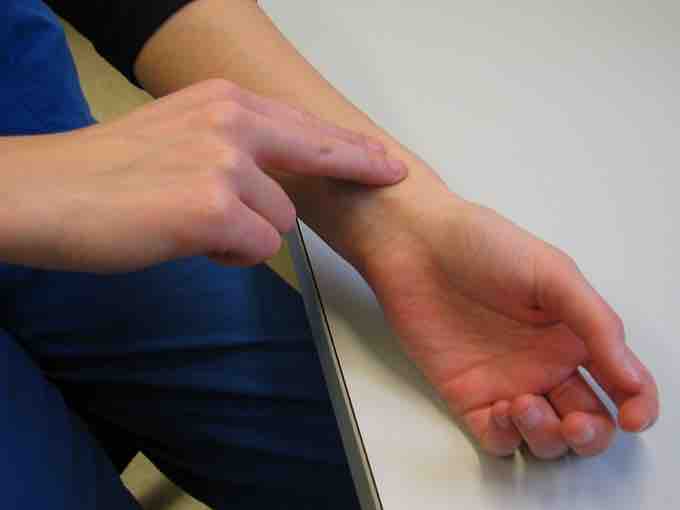The pulse is the physical expansion of an artery generated by the increase in pressure associated with systole of the heart. Pulse is often used as an equivalent of heart rate due to the relative ease of measurement; heart rate can be measured by listening to the heart directly through the chest, traditionally using a stethoscope. Pulse rate or velocity is usually measured either at the wrist from the radial artery and is recorded as beats per minute (bpm). Other common measurement locations include the carotid artery in the neck and popliteal artery behind the knee
Pulse varies with age; a newborn or infant can have a heart rate of about 130-150 bpm. A toddler's heart will beat about 100-120 times per minute, an older child's heartbeat is around 60-100 bpm, adolescents around 80-100 bpm, and a healthy adults pulse rate is anywhere between 50 and 80 bpm.

Measurement of the pulse
Measurement of the pulse can occur at several locations, including the radial artery shown here.
The heart rate may be greater or less than the pulse rate depending upon physiologic demand. In this case, the heart rate is determined by auscultation or audible sounds at the heart apex, not the pulse. The pulse deficit (difference between heartbeats and pulsations at the periphery) is determined by simultaneous palpation at the radial artery and auscultation at the heart apex.
Measurement Techniques
While a simple measurement of pulse rate is achievable by anyone, trained medical staff are capable of much more accurate measurements. Radial pulse is commonly measured using three fingers: the finger closest to the heart used to occlude the pulse pressure, the middle finger used get a crude estimate of blood pressure, and the finger most distal to the heart used to nullify the effect of the ulnar pulse as the two arteries are connected via the palmar arches.
Where more accurate or long-term measurements are required, pulse rate, pulse deficits, and more physiologic data are readily visualized by the use of one or more arterial catheters connected to a transducer and oscilloscope. This invasive technique has been commonly used in intensive care since the 1970's. The rate of the pulse is observed and measured by tactile or visual means on the outside of an artery and is recorded as beats per minute. The pulse may be further indirectly observed under light absorbencies of varying wavelengths with assigned and inexpensively reproduced mathematical ratios. Applied capture of variances of light signal from the blood component hemoglobin under oxygenated vs. deoxygenated conditions allows the technology of pulse oximetry.